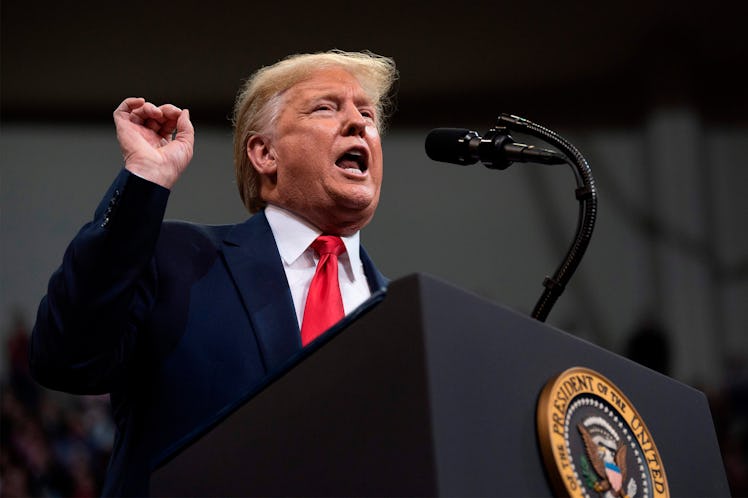
Trump's Proposed 2021 Budget Has Some People Upset
On Monday, Feb. 10, President Donald Trump's administration released its budget proposal for the 2021 fiscal year, and it's already stirring up some controversy. So, what's in Trump's budget for 2021? According to The New York Times, the $4.8 trillion budget includes some cuts to key social welfare and research programs, while defense gets additional spending.
Trump's 2021 budget proposal includes cuts to a variety of programs, including student loan assistance, affordable housing efforts, food stamps and Medicaid, per The New York Times. According to CNN, the Trump administration has proposed cutting billions of dollars from these and other federal safety net programs for poor Americans. More specifically, Trump's 2021 budget includes proposals to implement work requirements for Medicaid, tighten qualification standards for food stamps, and reduce retroactive disability benefits. In his 2021 budget, Trump also proposed cutting student loan spending by $170 billion, per CNBC, by eliminating government-subsidized loans and imposing lifetime loan limits for parents and graduate students.
These safety net cuts could have drastic consequences. Millions of Americans could potentially lose Medicaid and Affordable Care Act coverage under this budget proposal, CNN reported, and an estimated 3.7 million people would no longer qualify for food stamps. The proposed budget would also give Americans fewer repayment options for their student loans, and would do away with the public service loan forgiveness program, which enables not-for-profit and government employees to get their federal student loans canceled if they make on-time payments for 10 years. The White House did not immediately respond to a request for comment on the budget and whether or not these estimates were accurate.
Federal safety net programs are not the only things that Trump wants to cut in 2021, either. According to Vanity Fair, Trump's 2021 budget proposal would cut funding by 9% for the Department of Health and Human Services (HHS), which notably includes the Centers for Disease Control and Prevention (CDC). Under this proposed budget, the CDC could see cuts of up to 16%, per The Washington Post. But The New York Times reported that the CDC would get a boost in more focused funds under this proposed budget, in an attempt to "refocus" its efforts on infectious disease prevention and public health issues like the opioid crisis.
Notably, the Trump budget didn't allocate any funding toward combating gun violence, despite a December 2019 congressional deal to fund gun violence prevention research — something that hasn't been funded in more than 20 years, per The Washington Post. That deal allocated $12.5 million each to the CDC and the National Institutes of Health (NIH) to study gun violence prevention. Trump's proposed 2021 budget, on the other hand, currently allocates $0 for gun violence prevention research. In a statement emailed to Elite Daily, gun safety advocacy group Everytown for Gun Safety slammed Trump for being "so deep in the gun lobby’s pocket that he can no longer see daylight."
Even as the Trump administration is proposing funding cuts to gun violence prevention research and federal safety net programs, there are certain efforts that Trump is adamant about funding — and one of those is his border wall. Trump wants to cut environmental spending and foreign aid in the 2021 fiscal year, with a proposed 26% funding cut to the Environmental Protection Agency and a $3.7 billion reduction in funding for the State Department and international aid programs. But at the same time, he wants to allocate an additional $2 billion to build 82 more miles of wall on the U.S.-Mexico border, per Vox. Trump also wants to increase spending across the board to restrict immigration. According to Vox, his budget proposal calls for $3.1 billion to increase immigrant detention center capacities, $4 billion to care for unaccompanied migrant children once they've been moved to HHS custody, and $1.6 billion to increase staff sizes across government immigration agencies.
As The New York Times pointed out, Trump's budget proposal as it currently stands is unlikely to be approved by Congressional lawmakers. Democratic lawmakers — who have a majority in the House of Representatives — are expected to push back on many of Trump's proposed federal safety net budget cuts, as well as on his proposals to increase defense and border security spending. But as the November 2020 presidential election approaches, it is clear that Trump is trying to appeal to his conservative base with a budget that prioritizes security and military spending over social welfare and health care programs. These are all key topics this election cycle, and voters can expect to see more debates about all of these issues as the general election draws closer.